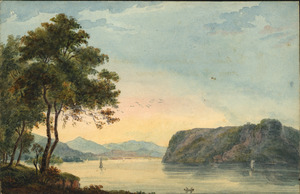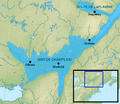St. Lawrence River facts for kids
Quick facts for kids St. Lawrence River |
|
|---|---|
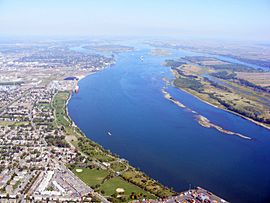
The St. Lawrence River in Montréal-Est, Quebec
|
|
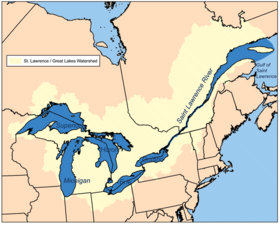
Map of the St. Lawrence/Great Lakes Watershed
|
|
| Other name(s) |
|
| Country | Canada, United States |
| Provinces | Ontario, Quebec |
| State | New York |
| Territories | Anishinaabewaki; Haudenosaunee Countries; Nitaskinan; Nionwentsïo; Nitassinan; Dawnland Countries |
| Physical characteristics | |
| Main source | Lake Ontario Kingston, Ontario / Cape Vincent, New York 74.7 m (245 ft) 44°06′N 76°24′W / 44.100°N 76.400°W |
| River mouth | Gulf of St. Lawrence / Atlantic Ocean Quebec, Canada 0 m (0 ft) 49°30′N 64°30′W / 49.500°N 64.500°W |
| Length | 500 km (310 mi) excluding the estuary. C. 928 km if included. |
| Discharge (location 2) |
|
| Discharge (location 3) |
|
| Discharge (location 4) |
|
| Basin features | |
| Basin size | 1,344,200 km2 (519,000 sq mi) |
The St. Lawrence River (French: Fleuve Saint-Laurent) is a huge river in North America. It starts from Lake Ontario and flows northeast into the Gulf of St. Lawrence. This river connects the Great Lakes to the Atlantic Ocean. It also helps drain the water from the entire Great Lakes Basin.
The St. Lawrence River flows through the Canadian provinces of Ontario and Quebec. It also touches the U.S. state of New York. Part of the river forms the border between Canada and the United States. It is also a very important route for ships, known as the St. Lawrence Seaway.
Contents
What's in a Name?
The St. Lawrence River has many names. Local Indigenous peoples called it different things. For example, the Mohawk call it Kaniatarowanénhne, which means "Big Water Current." The Algonquins call it Magtogoek, meaning "the Walking Path."
How the River Got its Current Name
In the 1500s, French explorers came to Canada. They called the river names like Grand fleuve de Hochelaga or Grande rivière du Canada. In French, fleuve means a river that flows into the sea.
The name "Saint Lawrence" came from Jacques Cartier. He arrived in the Gulf of St. Lawrence on August 10, 1535. This day is a special holiday for Saint Lawrence. So, Cartier named the bay after him. Later, in 1604, Samuel de Champlain put the name Fleuve sainct Laurens on a map. This is how the river got its current name.
River Geography: Where Does it Flow?
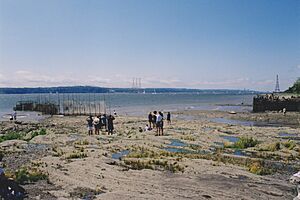
The St. Lawrence River was formed after the Champlain Sea dried up. This sea existed about 13,000 to 10,000 years ago. The land slowly rose, and the sea became smaller. Today, this process is still happening.
The river starts at Lake Ontario. It flows past many cities like Kingston, Montreal, and Quebec City. Finally, it empties into the Gulf of St. Lawrence. This gulf is one of the biggest estuaries (where a river meets the sea) in the world. Near Quebec City, the river's water starts to rise and fall with the ocean tides.
How Long and Wide is the St. Lawrence River?
The St. Lawrence River is very long! From its farthest starting point in Minnesota to the ocean, it's about 3,058 kilometers (1,900 miles). From Lake Ontario, it's about 1,197 kilometers (744 miles). If you don't count the wide estuary part, it's about 500 kilometers (300 miles) long from Lake Ontario.
The river's drainage basin is huge. This is the area of land where all the water flows into the river. It covers about 1,344,200 square kilometers (519,000 square miles). This area includes the Great Lakes, which are the world's largest system of freshwater lakes. The basin covers parts of Canada and the United States.
Lakes and Islands Along the River
The St. Lawrence River flows through several lakes, including Lake Saint Francis, Lake Saint-Louis, and Lake Saint Pierre. It also has many islands.
Some famous island groups are:
- The Thousand Islands near Kingston, Ontario.
- The Hochelaga Archipelago, which includes the Island of Montreal.
- The Lake St. Pierre Archipelago, which is a special biosphere reserve recognized by UNESCO.
Other important islands are Île d'Orléans near Quebec City and Anticosti Island. The St. Lawrence is the second longest river in Canada.
Rivers that Join the St. Lawrence
Many other rivers flow into the St. Lawrence. These include:
History of the St. Lawrence River
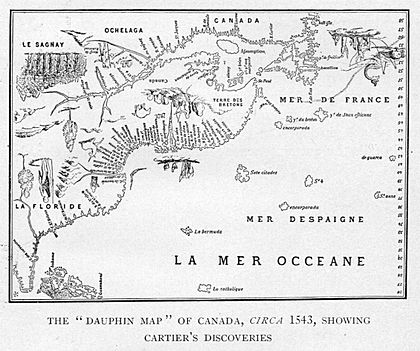
The St. Lawrence River has always been a key pathway for many people. It flows through the traditional lands of many Indigenous nations. These include the Innu, Mi'kmaq, Maliseet, Abenaki, Mohawk, Oneida, Onondaga, Huron-Wendat, and Algonquin nations.
Early European Explorers
Some historians believe that Norse explorers visited the Gulf of St. Lawrence around the 11th century. Later, in the 15th and 16th centuries, other European sailors like John Cabot explored the area.
The first European explorer known to sail up the St. Lawrence River itself was Jacques Cartier in 1535. At that time, the river banks were home to the St. Lawrence Iroquoians.
Basque people from Europe also came to the St. Lawrence Gulf and River in the early 1500s. They hunted whales and fished. They traded with Indigenous peoples and set up small settlements.
The River's Role in History
The St. Lawrence River was the main route for Europeans to explore inside North America. French explorer Samuel de Champlain was one of the first to use it this way.
During the Seven Years' War in the 1700s, controlling the river was very important for the British. They used it to sail to Quebec City and attack the French. This led to the Battle of the Plains of Abraham, where the British won.
Modern River Travel
In 1809, the first steamboat on the St. Lawrence River was built by John Molson. It was called the Accommodation. It carried passengers between Montreal and Quebec City. Soon, steamboats offered daily trips.
The St. Lawrence River used to have Lachine Rapids, which made it hard for large ships to pass Montreal. In 1825, the Lachine Canal was opened to help ships get around these rapids.
Later, a much bigger system of canals and locks was built. This is called the Saint Lawrence Seaway. It opened in 1959. The Seaway allows large ocean ships to travel all the way to Lake Superior!
During World War II, there were battles in the lower St. Lawrence River and Gulf. German U-boats (submarines) attacked ships there.
In the late 1970s, people started a campaign called "Save the River." They wanted to protect the river from development. This campaign was very successful.
Amazing Animals: Whales of the St. Lawrence
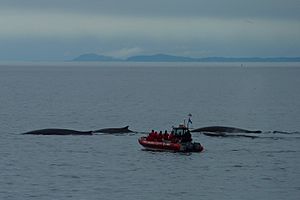
The St. Lawrence River is home to many different kinds of whales, especially in its wider estuary parts. It's a special place where you can sometimes see these huge animals!
Here are some of the whales that live or visit the St. Lawrence:
- Beluga whale
- Sperm whale
- Humpback whale
- Minke whale
- Fin whale
- Blue whale
- Northern bottlenose whale
- Northern Atlantic right whale (this one is very rare and protected)
- Bowhead whale (seen sometimes)
Where the River Begins: Its Sources
The St. Lawrence River is part of a very large water system. Its farthest starting point is the North River in Minnesota. Because the water flows through so many lakes, the name of the waterway changes along the way.
Here are the names of the water bodies, from the very beginning to the St. Lawrence River itself:
- North River
- Saint Louis River
- Lake Superior
- St. Marys River
- Lake Huron
- St. Clair River
- Lake St. Clair
- Detroit River
- Lake Erie
- Niagara River
- Lake Ontario
The St. Lawrence River also flows through Lake Saint-Louis and Lake Saint-Pierre in Quebec.
The St. Lawrence in Art and Culture
The St. Lawrence River is a big part of Canadian culture, especially in Quebec. It has inspired many artists, writers, and musicians.
- Novels and Poems: Many books, like Kamouraska by Anne Hébert, are set along the river. Poets like Pierre Morency have written about it too.
- Songs: Famous songs like "Suzanne" by Leonard Cohen and "Le Saint-Laurent" by André Gagnon celebrate the river.
- TV Shows and Films: The Canadian TV show Seaway was set on the river. In 1980, Jacques Cousteau, a famous ocean explorer, made two films about the St. Lawrence River and the Great Lakes. The movie Black Robe also takes place on the river in the 1600s.
- Paintings: Artists, including the famous Group of Seven, have painted beautiful scenes of the St. Lawrence.
Images for kids
-
Cross commemorating the one laid by Jacques-Cartier on October 7, 1535, Trois-Rivières
See also
 In Spanish: Río San Lorenzo para niños
In Spanish: Río San Lorenzo para niños
- Gulf of St. Lawrence
- Estuary of St. Lawrence
- Lac Saint-Pierre
- Lachine Rapids
- RMS Empress of Ireland
- St. Lawrence Seaway
- Steamboats in Canada
- NEPCO 140 Oil Spill
- Boldt Castle
- Container on barge
- Grindstone Island
- Jorstadt Castle
- Wellesley Island
- Maison Drouin
- List of longest rivers of the United States (by main stem)
- List of longest rivers of Canada
- List of Quebec rivers
- List of Ontario rivers
- List of New York rivers
- List of crossings of the St. Lawrence River


